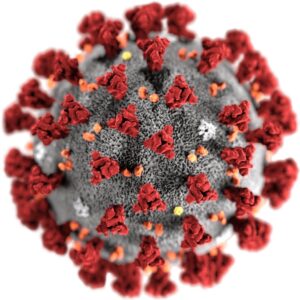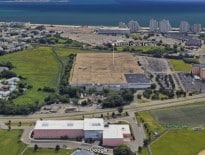
An illustration of the new coronavirus that causes the disease COVID-19. Image courtesy of the Centers for Disease Control.
More than two months after Massachusetts embarked on its gradual economic and social reopening plan, the rate of positive COVID-19 tests is lower than it was before pandemic-shuttered businesses first began stirring back to life, Gov. Charlie Baker said Wednesday.
“We actually had a higher positive test rate two and a half months ago than we have today, which speaks not only to the strategic decision-making that went into developing and implementing that plan, but it also speaks in a very big way to the work that’s continued to be done by the people in Massachusetts to do the things that we know are most successful in containing the virus and reducing the spread,” Baker said.
Those strategies, Baker reiterated, include wearing face coverings, keeping distance from others and choosing to spend time outdoors instead of indoors when possible.
As of Monday, the seven-day weighted average of positive COVID-19 tests stood at 1.7 percent, and it has been below 2 percent for all of July. When the earliest steps of the Baker administration’s reopening plan began on May 18, that figure was 9.6 percent.
The governor held his Wednesday press conference, his first public appearance of the week, at the Lynn outpost of the Salvation Army, marking what he called an “incredibly important” milestone — the organization has now distributed 8 million meals in Massachusetts since March.
Lynn is one of eight communities in Massachusetts where the Baker administration has launched free testing sites, which will run through mid-August, as part of its “Stop the Spread” initiative.
The communities – Chelsea, Everett, Fall River, Lawrence, Lowell, Marlborough and New Bedford are the others – were chosen because the number of cases and positive test rates there exceed the state average, but the volume of testing has dropped over the past two months.
“We know that targeted testing and tracing combined with the things that individuals can do to stop the spread can work, and in some respects it’s how Massachusetts and Lynn have been able to reopen at a point in time and continue to maintain the kind of positive public health metrics that we’ve been reporting daily now for almost three months,” Baker said.
Baker said his administration is “currently doing a pretty deep dive on all of our test results from the past few weeks,” and will “have more to say about it later this week.”
As COVID-19 cases have spiked in other parts of the country, the growing demand for testing has in some instances led to longer wait times for results.




 |
| 

